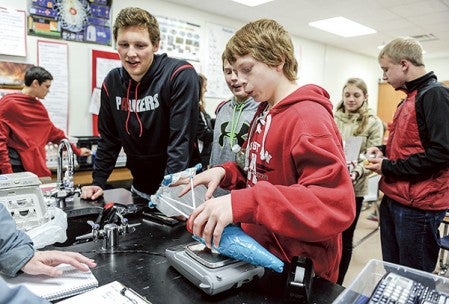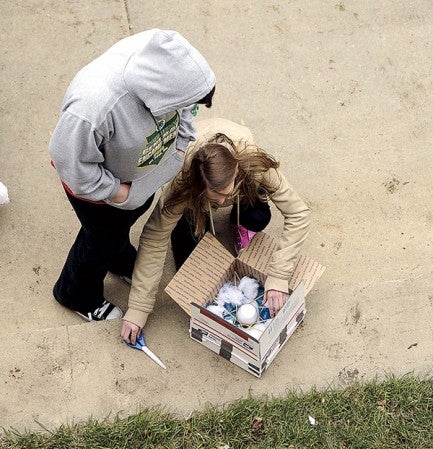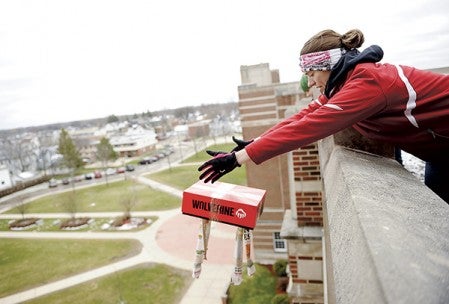Bombs away; Ninth-grade students learn STEM values through egg drop
Published 1:01 pm Sunday, April 12, 2015

A container containing an egg falls from the roof of Austin High School Friday morning, carried slowly by four plastic bags acting as parachutes. Students in the freshman physical science class came up with containers they hoped would carry the eggs safely to the ground.
After several devices carrying eggs hit the ground hard, an egg secured in the middle of a straw-structure floated down and landed, egg fully intact, from the roof of Austin High School, about 15.1 meters.

Caleb Philstrom puts the egg container for he and Logan Braaten’s (left) egg on a scale to weigh it with the egg before it was taken to the top of the school.
“We thought that the wind would pick up the straws and [go] through the parachute and with the light weight it would land easy, not hard,” Kellie Baier said about her and her class partner, Kelsey Feuerhak’s egg device.
The Austin ninth-grade physical science classes — 11 in total — have spent the last week and a bit of time before spring break planning and building carriers for eggs that, when dropped from the school’s roof, would protect the thin shell from cracking. The egg drop, which has taken place for at least seven years, according to science teacher Tisha Pischke, is meant to apply what students have been learning in class to a hands-on project.
“[We learned] how to keep an egg safe, and just the design and how to consider the wind and weather and all that to make it land safely,” Kelsey said.
Some of the other devices fell much harder than Kellie and Kelsey’s structure.
“Ours got a lot of air through it,” Kellie said. “So the air kind of picked it up and made it go a lot slower than some of the other ones.”
The egg drop went on all day Friday, with students judging the eggs and devices on the ground after teachers let them fall from the roof.
Teachers also collected data as the eggs fell, such as how long it took to drop. Pischke was excited to see the students applying their learning to a hands-on activity, and said the students will be able to learn many things from this.

Amy Stoulil opens her box to check if her egg survived the drop from the roof of Austin High School Friday morning as part of the freshman physical science class. Classmate Olivia Bernand waits for the verdict with her. Eric Johnson/photodesk@austindailyherald.com
“This is the end of our physics unit, so we’re talking about energy, and we talked about speed, and we talked about forces in motion — so Newton’s laws of motion,” she said. “… They built an egg drop device and will think about Newton’s second law of motion. Basically the more mass you have you’re going to fall with a greater force.”
Sam Bailey and Joshua Bollum’s egg had a soft landing as the pillow they attached the egg to caught the air and fell slowly, landing with a soft thud. They chose to use a pillow because they didn’t want the egg to crack, according to Joshua. They also added a parachute to the device, which helped catch the wind.
“We thought a parachute would help break the fall,” Sam said.
The two were excited when they found their egg still intact after the fall, and said they chose a pillow because it was soft and accessible.
“We had extra pillows at home,” Josh said.
“I think ours did better than we thought it would,” Sam added.

Teacher Jennifer Hillger drops a container with an egg from the roof of Austin High School Friday morning. The freshmen students made containers to test if an egg could survive for the physical science class. Eric Johnson/photodesk@austindailyherald.com.
The students will now take the data collected from the drop and find their mass, average speed, momentum, weight, kinetic energy, gravitational potential energy, and more. Pischke said the project also included the aspects of STEM —science, technology, engineering and math.
“It’s just basically everything that we’ve studied into a real-life application,” she said.
Although the day is hectic, Pischke said it is well worth the fun and high energy the students have for the project.
“It’s just fun,” she said. “Every year I have people who maybe are not the best book learners, but man they are so hands on with learning.”
“It’s chaotic for the teachers but the kids really like it,” she added.





